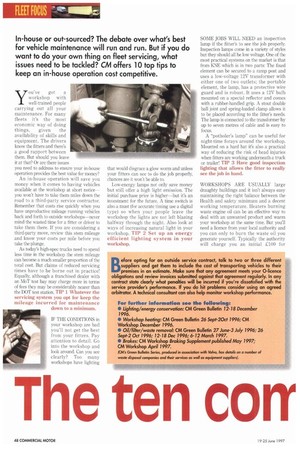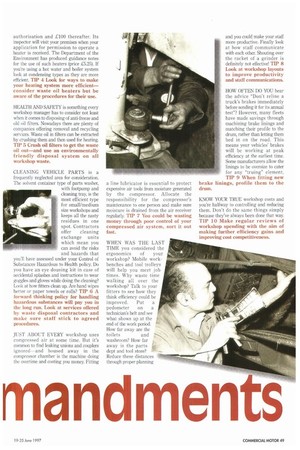The ten coni
Page 50

Page 51

If you've noticed an error in this article please click here to report it so we can fix it.
mandmen
In-house or out-sourced? The debate over what's best for vehicle maintenance will run and run. But if you do want to do your own thing on fleet servicing, what issues need to be tackled? CM offers 10 top tips to keep an in-house operation cost competitive.
you've got a workshop with well-trained people carrying out all your maintenance. For many
fleets it's the most economic way of doing things, given the availability of skills and equipment. The drivers know the fitters and there's a good rapport between them. But should you leave it at that? Or are there issues you need to address to ensure your in-house operation provides the best value for money?
An in-house operation will save you money when it comes to having vehicles available at the workshop at short notice— you won't have to take them miles down the road to a third-party service contractor. Remember that costs rise quickly when you have unproductive mileage running vehicles back and forth to outside workshops—never mind the wasted time for a fitter or driver to take them there. If you are considering a third.party move, review this stem mileage and know your costs per mile before you take the plunge.
As today's high-spec trucks need to spend less time in the workshop the stem mileage can become a much smaller proportion of the total cost. But claims of reduced servicing times have to be borne out in practice! Equally, although a franchised dealer with an MoT test bay may charge more in terms of fees they may be considerably nearer than the DOT test station. TIP 1 Whatever the servicing system you opt for keep the mileage incurred for maintenance down to a minimum.
IF THE CONDITIONS in your workshop are bad you'll not get the best from your fitters. Pay attention to detail. Go into the workshop and look around. Can you see clearly? Too many workshops have lighting
that would disgrace a glow worm and unless your fitters can see to do the job properly, chances are it won't be able to.
Low-energy lamps not only save money but still offer a high light emission. The initial purchase price is higher—but it's an investment for the future. A time switch is also a must (for accurate timing use a digital type) so when your people leave the workshop the lights are not left blazing halfway through the night. Also look at ways of increasing natural light in your workshop. TIP 2 Set up an energy efficient lighting system in your workshop. SOME JOBS WILL NEED an inspection lamp if the fitter's to see the job properly, Inspection lamps come in a variety of styles but they should all be low voltage. One of the most practical systems on the market is that from KNE which is in two parts: The fixed element can be secured to a ramp post and uses a low-voltage 12V transformer with either one of two outlets; the portable element, the lamp, has a protective wire guard and is robust. It uses a 12V bulb mounted on a special reflector and comes with a rubber-handled grip. A stout double ball joint and spring-loaded clamp allows it to be placed according to the fitter's needs. The lamp is connected to the transformer by up to seven metres of cable and is easy to focus.
A "potholer's lamp" can be useful for night-time forays around the workshop. Mounted on a hard hat it's also a practical way of reducing the risk of head injuries when fitters are working underneath a truck or trailer! TIP 3 Have good inspection lighting that allows the fitter to really see the job in hand.
WORKSHOPS ARE USUALLY large draughty buildings and it isn't always easy maintaining the right balance between the Health and safety minimum and a decent working temperature. Heaters burning waste engine oil can be an effective way to deal with an unwanted product and warm your workshop at the same time. But you'll need a licence from your local authority and you can only to burn the waste oil you generate yourself. Typically the authority will charge :yam an initial C100 for authorisation and £100 thereafter. Its inspector will visit your premises when your application for permission to operate a heater is received. The Department of the Environment has produced guidance notes for the use of such heaters (price ,£5.25). If you're using a hot water and boiler system look at condensing types as they are more efficient. TIP 4 Look for ways to make your heating system more efficient— consider waste oil heaters but be aware of the procedures for their use.
HEALTH ANT) SAFETY is something every workshop manager has to consider not least when it comes to disposing of anti-freeze and old oil filters. Nowadays there are plenty of companies offering removal and recycling service& Waste oil in filters can be extracted by crushing them and then used for heating. TIP 5 Crush oil filters to get the waste oil out—and use an environmentally friendly disposal system on all workshop waste.
CLEANING VEHICLE PARTS is a frequently neglected area for consideration. The solvent container type of parts washer, with footpunnp and cleaning tray, is the most efficient type for small/medium size workshops and keeps all the nasty residues in one spot. Contractors
offer cleaning exchange units which mean you can avoid the risks and hazards that you'll have assessed under your Control of Substances Hazardous to Health policy. Do you have an eye dousing kit in case of accidental splashes and instructions to wear goggles and gloves while doing the cleaning? I.xxrk at how titters clean up. Are hand wipes better or paper towels or rolls? TIP 6 A forward thinking policy for handling hazardous substances will pay you in the long run. Look at services offered by waste disposal contractors and make sure staff stick to agreed procedures.
JUST ABOUT EVERY workshop uses compressed air at some time. But it's common to find leaking unions and couplers ignored-and housed away in the compressor chamber is the machine doing the overtime and costing you money. Fitting
a line lubricator is essential to protect expensive air tools from moisture generated by the compressor. Allocate the responsibility for the compressor's maintenance to one person and make sure moisture is drained from the air receiver regularly. TIP 7 You could be wasting money through poor control of your compressed air system, sort it out fast.
WHEN WAS THE LAST TIME you considered the ergonomics of your workshop? Mobile workbenches and tool trolleys will help you meet job times. Why waste time walking all over the workshop? Talk to your fitters to see how they think efficiency could be improved. Put a pedometer on a technician's belt and see what shows up at the end of the work period. How far away are the
toilets and washroom? How far z away is the parts k„ dept and tool store? Reduce these distances through proper planning
and you could make your staff more productive. Finally look at how staff communicate with each other. Shouting over the racket of a grinder is definitely not effective! TIP 8 Look at workshop layouts to improve productivity and staff communications.
HOW 01.7EN DO YOU hear the advice "Don't reline a truck's brakes immediately before sending it for its annual test''? However, many fleets have made savings through machining brake linings and matching their profile to the drum, rather than letting them bed in on the road. This means your vehicles' brakes will be working at peak efficiency at the earliest time. Some manufacturers allow the linings to be oversize to cater for any 'truing" element. TIP 9 When fitting new brake linings, profile them to the drum.
KNOW YOUR TRUE workshop costs and you're halfway to controlling and reducing them. Don't do the same things simply because they've always been done that way. TIP 10 Make regular reviews of workshop spending with the aim of making further efficiency gains and hnproving cost competitiveness.
efore opting for an outside service contract, talk to two or three different suppliers and get them to include the cost of transporting vehicles to their premises in an estimate. Make sure that any agreement meets your 0-licence obligations and review invoices submitted against that agreement regularly. In any contract state clearly what penalties will be incurred if you're dissatisfied with the service provider's performance. If you do hit problems consider using an agreed arbitrator. A technical consultant can also help monitor workshop performance.
For further information see the following: • Lighting/energy conservation: CM Green Bulletin 12-18 December 1996.
• Workshop heating: CM Green Bulletin 26 Sept-20ct 1996; CM Workshop December 1996.
• Oil/filter/waste removal: CM Green Bulletin 27 June-3 July 1996; 26 Sept-2 Oct 1996; 12-18 Dec 1996; 6-12 March 1997.
• Brakes: CM Workshop Braking Supplement published May 1997; CM Workshop April 1997.
/CM's Green Bulletin Series, produced in association with Volvo, has derails on a number of waste disposal companies and their services as well as equipment suppliers).






















































































































